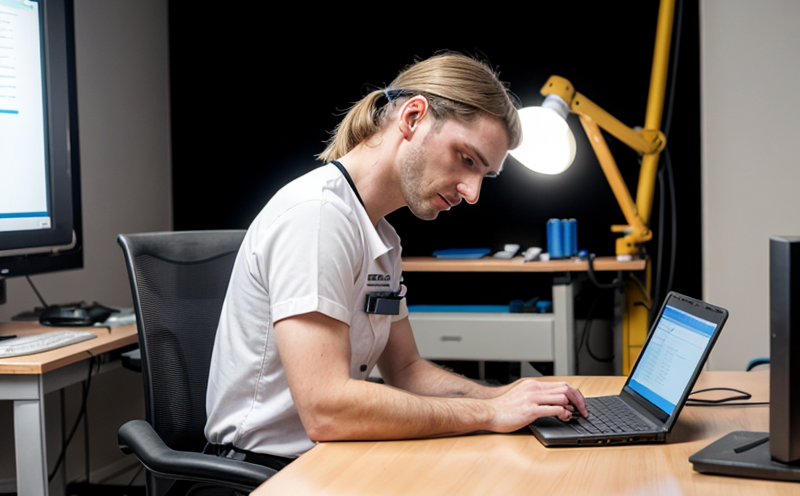EASA CS-29 Rotorcraft Crew Interface Ergonomic Testing
The European Aviation Safety Agency (EASA) CS-29 regulations are pivotal in ensuring rotorcraft meet stringent safety and operational requirements. The crew interface ergonomic testing, as specified under EASA CS-29, is a critical component that evaluates the design of cockpit interfaces to ensure they are ergonomically sound and safe for pilots, co-pilots, and other crew members. This testing ensures that controls, displays, and other human-machine interfaces are optimized for usability, comfort, and safety.
The ergonomic evaluation focuses on reducing the risk of fatigue, stress, and injury during prolonged flight operations. This is achieved by assessing the physical layout of cockpit components, their visibility, and accessibility under various flight conditions. The testing also ensures that crew members can operate controls efficiently, minimizing errors and enhancing overall operational performance.
The standards for ergonomic design are outlined in EASA CS-29 Annex 16A, which provides specific guidelines on the evaluation of human factors and ergonomics within rotorcraft cockpits. These standards emphasize the importance of crew comfort during critical flight phases such as takeoff, landing, and emergency procedures.
The testing process involves a series of evaluations that simulate real-world flight scenarios to assess the ergonomic aspects of cockpit interfaces. This includes evaluating the visibility of instruments under different lighting conditions, assessing the reachability of controls for all crew members, and ensuring that the design is conducive to minimizing pilot fatigue during long flights.
Accurate instrumentation plays a crucial role in this testing process. The use of high-precision measurement tools allows for precise assessments of ergonomic parameters such as control placement, instrument visibility, and seating comfort. These instruments are calibrated to international standards (ISO 9241) to ensure consistent and accurate results.
The testing also involves the evaluation of cockpit layout designs using software simulation tools that replicate real flight conditions. This allows for a comprehensive assessment of ergonomic aspects before physical prototypes are developed, ensuring that any design flaws can be identified early in the development process.
One key aspect of this testing is the evaluation of control forces and travel ranges, which directly impact crew comfort and efficiency during operation. The testing ensures that these parameters comply with EASA standards to prevent excessive force application or discomfort during critical maneuvers.
The final phase of the testing involves a comprehensive review of the cockpit design by experienced ergonomists who assess the overall ergonomic suitability based on real-world usage notes. This includes feedback from pilots and other crew members, which is invaluable in refining the design for optimal performance.
Scope and Methodology
The scope of EASA CS-29 Rotorcraft Crew Interface Ergonomic Testing encompasses a wide range of ergonomic evaluations aimed at ensuring safe and efficient cockpit operations. This includes the assessment of control layout, instrument placement, and seating arrangements to ensure they are ergonomically suitable for all crew members.
- Control Layout Evaluation: Ensuring that controls are placed in logical positions for easy access.
- Instrument Placement Assessment: Checking that instruments are visible under various lighting conditions.
- Seating Comfort Analysis: Evaluating the comfort and support provided by seating arrangements.
The methodology involves a combination of theoretical analysis, simulation using advanced software tools, and physical testing. The process begins with a detailed review of the design specifications and ergonomic guidelines outlined in EASA CS-29 Annex 16A. This is followed by the creation of three-dimensional models to simulate flight scenarios.
The physical tests involve placing volunteers in simulated cockpit environments to evaluate their comfort and ease of operation. The data collected from these tests is analyzed using statistical methods to ensure compliance with ergonomic standards.
The final phase of the testing involves a comprehensive review by ergonomists who provide feedback on any areas that require improvement. This iterative process ensures that the final design meets all specified ergonomic requirements, enhancing crew comfort and safety during flight operations.
Eurolab Advantages
As a leading laboratory specializing in aerospace testing, Eurolab offers unparalleled expertise in EASA CS-29 Rotorcraft Crew Interface Ergonomic Testing. Our team of experienced engineers and ergonomists ensures that every test is conducted with the highest level of accuracy and precision.
- Comprehensive Expertise: Our team has extensive experience in aerospace testing, ensuring that we can provide tailored solutions for your specific needs.
- State-of-the-Art Facilities: Utilizing advanced instrumentation and simulation tools, our laboratory is equipped to handle the most complex ergonomic evaluations.
- Compliance with International Standards: Our tests are conducted in strict adherence to EASA CS-29 Annex 16A standards, ensuring compliance with international regulations.
- Iterative Testing Process: We employ an iterative testing process that ensures continuous improvement and refinement of design elements.
We offer a range of services including initial design reviews, detailed ergonomic assessments, and comprehensive reporting. Our goal is to provide you with reliable data that can be used to make informed decisions about your rotorcraft designs.
Use Cases and Application Examples
| Use Case | Description | Ergonomic Evaluation Focus |
|---|---|---|
| Cockpit Layout Design | Determining the optimal placement of controls and instruments for easy access. | Control layout evaluation, instrument visibility assessment. |
| Seating Arrangement Analysis | Evaluating seating comfort and support for all crew members. | Seating comfort analysis, ergonomic suitability review. |
| Critical Maneuver Evaluation | Assessing the ergonomics of controls during critical flight phases such as takeoff and landing. | Control forces and travel range evaluation. |
| Emergency Procedure Simulation | Evaluating ergonomic aspects under emergency conditions to ensure crew safety. | Instrument placement assessment, seating comfort analysis. |
- Cockpit Layout Design: Ensuring controls are logically placed for easy access during critical flight phases.
- Seating Arrangement Analysis: Evaluating the comfort and support provided by seating arrangements for all crew members.
- Critical Maneuver Evaluation: Assessing ergonomic aspects of controls during takeoff, landing, and other critical maneuvers.
- Emergency Procedure Simulation: Ensuring that cockpit design is ergonomically suitable under emergency conditions to enhance crew safety.





